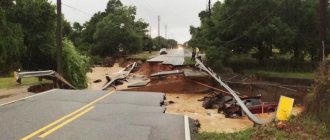1. Poisoning, contamination or other damage to land by harmful products of economic or other activities due to violation of the rules for handling fertilizers, plant growth stimulants, pesticides and other dangerous chemical or biological substances during their storage, use and transportation, resulting in harm to human health or the environment , —
shall be punishable by a fine in the amount of up to two hundred thousand rubles, or in the amount of the wages or other income of the convicted person for a period of up to eighteen months, or by deprivation of the right to hold certain positions or engage in certain activities for a term of up to three years, or by compulsory labor for a term of up to four hundred eighty hours, or correctional labor for up to two years.
2. The same acts committed in a zone of environmental disaster or in a zone of environmental emergency -
shall be punishable by restriction of freedom for a term of up to two years, or forced labor for a term of up to two years, or imprisonment for the same term.
3. Acts provided for in parts one or two of this article, resulting in the death of a person through negligence, -
shall be punished by forced labor for a term of up to five years or imprisonment for the same term.
Commentary to Art. 254 of the Criminal Code of the Russian Federation
1. The main direct object of the crime is relations for the protection and rational use of land, ensuring environmental safety. Additional - relations to protect the health or life (Part 3 of the article) of a person.
Relations regarding the protection and use of land resources are regulated by the Constitution, the Land Code, the Federal Law of July 19, 1997 N 109-FZ “On the safe handling of pesticides and agrochemicals”, the Laws on sanitary and epidemiological welfare, on environmental protection, as well as other regulatory legal acts .
2. The subject of the crime is land, i.e. surface soil layer.
3. The objective side of the crime is expressed very casuistically. It is characterized by damage to land, accomplished alternatively by poisoning, contamination or other damage by harmful products of economic or other activities due to violation of the rules for handling fertilizers, plant growth stimulants, pesticides and other hazardous chemical or biological substances during their storage, use and transportation. ——————————— In our opinion, in the text of Part 1 of Art. 254 of the Criminal Code after the words “or other activities” the word “or” must be inserted.
Poisoning is the saturation of the soil with pesticides or poisonous (toxic) products of economic activity, as a result of which the soil becomes dangerous to the health of people, animals, insects, plants and other organisms and the use of it can cause their death.
Pollution consists of a physical, chemical, biological change in the quality of the soil, which exceeds established standards for harmful effects and poses a threat to human health, the state of flora and fauna.
Other damage to the earth (as well as poisoning or pollution) is associated only with violation of the rules for handling hazardous chemical or biological substances. Therefore, other damage to the land does not include clogging the land with garbage or waste, setting up landfills without permission, landfills, damaging the land with sewage and mechanical means (demolition of the fertile layer, violation of land reclamation rules, digging ditches, dumping dumps, flooding, contributing to the formation of ravines and wind damage). erosion, etc.). These acts can only entail administrative liability.
Other damage may include rendering the land unusable due to the appearance of dangerous chemical compounds in it after the use of fertilizers or pesticides in violation of the rules, the proliferation of dangerous organisms, pests, or the destruction of beneficial organisms.
Fertilizers are organic and mineral substances containing plant nutrients. They are applied to the soil, the solution is sprayed on the plants, and the seeds are treated.
Of the agrochemicals and biological substances, pesticides are most often used - a very large group of chemical and biological means of combating pests and plant diseases, weeds, pests of grain and grain products, wood, wool, leather, cotton products, ectoparasites of domestic animals, and vectors. diseases of humans and animals. Pesticides also include plant growth regulators.
Maximum permissible standards for the use of agrochemicals in agriculture are established in doses that ensure health protection, preservation of the human genetic fund, flora and fauna, and are approved by specially authorized state bodies of the Russian Federation in the field of environmental protection and sanitary and epidemiological surveillance, taking into account international standards.
Other hazardous chemical or biological substances include those that are subject to mandatory state registration on the basis of the Post. Government of the Russian Federation dated July 20, 2013 N 609 “On maintaining the federal register of potentially hazardous chemical and biological substances, amending and invalidating certain acts of the Government of the Russian Federation.”
The Federal Register of Potentially Hazardous Chemical and Biological Substances is a state information resource created for the purpose of implementing the relevant international treaties of the Russian Federation, including the Rotterdam Convention on the Prior Informed Consent Procedure for Certain Hazardous Chemicals and Pesticides in International Trade of September 10, 1998, and requirements legislation of the Russian Federation. The register is maintained by Rospotrebnadzor.
The information contained in the register can be used for the purpose of state registration of potentially dangerous chemical and biological substances and preparations made on their basis that pose a potential danger to humans (except for medicines), individual substances (compounds) of natural or artificial origin, capable under production conditions, application, transportation, processing, as well as in domestic conditions have an adverse effect on human health and the environment, as well as federal state sanitary and epidemiological supervision and federal state environmental supervision. ——————————— See: clause 8 of section II of the decision of the Customs Union Commission dated May 28, 2010 N 299 “On the application of sanitary measures in the Eurasian Economic Union.”
Consequences are an obligatory sign of a crime: they are expressed in harm to human health (see commentary to Article 246) or harm to the environment, i.e. death of vegetation, herbivores and other animals, bringing the soil into a state unsuitable for use in agriculture or for performing environmental functions (see commentary to Article 247).
The crime is completed if pollution, poisoning or other damage to the land causes harm to human health or the environment. A causal relationship must be established between the actions (inactions) named in the law and the consequences. The corpus delicti is material.
4. From the subjective side, the crime is characterized by an intentional or careless form of guilt (see commentary to Part 1 of Article 250).
5. The subject of the crime is a sane individual who has reached the age of 16, who, by the nature of his work, uses fertilizers, plant growth stimulants, poisons, other chemical and biological preparations and substances (employees of research institutes, cultivators of fields, gardens, forests) , as well as warehouse workers and other persons obliged to comply with safety rules when handling these substances.
6. A qualifying attribute (Part 2 of the commented article) is damage to land in an environmental disaster zone or in an environmental emergency zone (see commentary to Article 247). The concept of “the same acts” should be interpreted similarly to those discussed in Part 2 of Art. 250 of the Criminal Code of the Russian Federation. The corpus delicti is formal.
7. A particularly qualifying feature (Part 3 of the commented article) is the infliction of those listed in Parts 1 and 2 of Art. 254 of the Criminal Code for acts of negligence causing death to a person.
8. Criminal damage to land, which is mentioned in Part 1 of the commented article, differs from administratively punishable land offenses (Articles 8.6 - 8.8, 8.12 of the Administrative Code) in terms of consequences and other signs of the objective side. Criminal damage to land is carried out by actions (inaction) that are not provided for in the listed articles of the Code of Administrative Offenses. In addition, the crime provides consequences in the form of harm to human health or the environment or death of a person. There are no consequences provided for in administratively punishable offenses.
Analytics Publications
Guided by Article 7 of the Land Code of the Russian Federation, courts recognize the use of a land plot as inappropriate if the plot is used not in accordance with its belonging to one or another category of land.
It should be noted that courts often use the term “misuse of a land plot” also in the case of using a plot not in accordance with the type of permitted use (APU) established for it.
The consequence of this, in particular, may be a requirement for the demolition of unauthorized buildings.
Let's consider several examples of the courts' qualification of the defendant's actions in connection with the plaintiff's arguments about the misuse of a land plot.
The Supreme Court of the Russian Federation supported the conclusions of the lower courts, which recognized the defendant’s actions as inappropriate use of the land plot and ordered the demolition of the buildings erected on this site[1].
The court found that the defendant, who is the owner of a land plot classified as agricultural land (agricultural land), erected hangars on its territory. According to the defendant, these buildings were intended for storing agricultural products. At the same time, the prosecutor who filed claims for the demolition of these buildings presented to the court evidence of the use of hangars for storing aircraft. As a result, the court supported the prosecutor's arguments about the defendant's misuse of the land plot and ordered the demolition of these buildings.
Of interest is the position of the courts that the inappropriate use of a building (part of it) located on a land plot is not a sign of inappropriate use of the land plot[2]. This position seems uncontroversial, since in fact the economic activity of a person on a land plot is determined precisely by how the objects located on it are used, and the inappropriate use of real estate is directly related to the inappropriate use of the land plot.
For example, the Arbitration Court of the Moscow District found that the owner of a land plot, which was assigned a VRI - operation of a warehouse complex, uses the warehouse premises located on it to locate offices[3]. The court, however, did not agree with the arguments of the Rosreestr Office that this fact indicates the misuse of the land plot. On the contrary, the court indicated that the use of premises in a non-residential building relates to the issue of the use of real estate, not land.
A similar approach was applied by the Court of the Central District in case No. A08-72/2017, which established that one of the premises of a non-residential building for industrial purposes, located on a land plot that has a VRI - for the placement and operation of industrial buildings and structures, is used in trading activities.
At the same time, in another case, the court declared illegal the actions of the defendant in the construction and operation of a shopping pavilion on a land plot that has a temporary construction site for servicing the club building. The court rejected the defendant’s arguments that he uses the shopping pavilion to service the club and, therefore, its construction on a land plot does not indicate misuse of such a plot[4].
Let us also dwell on court case No. 31-AD17-5, considered by the Supreme Court of the Russian Federation on May 12, 2021.
In this case, the owner of a land plot classified as residential land and having a VRI for the operation of a garage box placed a support for a cellular radiotelephone network station with the appropriate equipment on the roof of the garage box. Thus, according to the Rosreestr Office, the owner did not use the land for its intended purpose. The court did not agree with this position, stating the following.
The classifier of types of permitted use of land plots [5] (Classifier) establishes that the content of the VRI allows, without a separate indication in the Classifier, the placement and operation of a linear facility (except for public railways and public roads of federal and regional significance), the placement of protective structures ( plantings), land reclamation objects, antenna-mast structures, information and geodetic signs, unless otherwise provided by federal law.
Based on the specified provision of the Classifier and the explanations of the Ministry of Economic Development of the Russian Federation, given in letter No. D23i-1239 dated March 18, 2016, the court came to the conclusion that the placement of antenna mast structures is allowed on land plots with any VRI (including on land plots with in the VRI of which the location of communication facilities is not specifically stipulated) without additional cadastral registration of changes in terms of the permitted use of the land plot.
In addition to cases of inappropriate use of a land plot, it should be noted that the use of a land plot not in accordance with the purpose of its provision, specified, for example, in a lease agreement, may become grounds for termination of this agreement, as well as the application of contractual liability, if any [6 ]. In particular, for failure to comply with the purpose of providing a land plot, a penalty or rent may be charged, calculated taking into account an increasing factor.
At the same time, the fact of using the land plot in accordance with its intended purpose (that is, the absence of violations associated with the use of the land plot not in accordance with the category of land and VRI) does not exclude the civil liability of the tenant for the use of the land plot not in accordance with the purpose of its provision and the tenant's right to demand termination of the contract.
For example, the Moscow Arbitration Court satisfied the tenant’s request to terminate the lease agreement for a land plot provided for the purpose of operating a cafe building after the cafe was demolished by the tenant[7]. The court indicated that the demolition of the cafe building should be qualified on the basis of Article 451 of the Civil Code of the Russian Federation as a significant change in circumstances, giving the land lessor the right to early termination of the lease agreement.
Courts satisfy demands for termination of a lease agreement under similar circumstances, also applying the provisions of Article 450, paragraph 1 of Article 619 of the Civil Code of the Russian Federation on a significant violation of the terms of the agreement as a basis for its termination.
At the same time, not only the fact of misuse of a land plot can become a basis for prosecution, but also non-use of a land plot in cases provided for by parts 2, 2.1 and 3 of the Code of Administrative Offenses of the Russian Federation.
Let us consider individual issues of liability for misuse of land in more detail.
1. Bringing to administrative liability
Administrative liability for misuse of land is established by Part 1 of Art. 8.8 of the Code of Administrative Offenses of the Russian Federation, while this article covers the use of the site both not in accordance with its intended purpose, taking into account its category, and in violation of the VRI.
According to statistics published by Rosreestr (authorized to consider this category of cases), as of 01/01/2016[8] 5,861 persons were held accountable for using land plots other than their intended purpose, the total amount of fines imposed amounted to more than 200 million rubles, However, less than half of the identified violations were eliminated - only 2,625.
Sanction for committing an offense under Part 1 of Art. 8.8 of the Code of Administrative Offenses of the Russian Federation is a fine. Since March 2015, the amount of fines has been significantly increased, and a new mechanism for calculating the fine has been established: in an amount that is a multiple of the cadastral value of the site. So, now an organization can be fined in the amount of 1.5 to 2% of the cadastral value of the site, but not less than 100 thousand rubles. (previously, the liability of organizations was limited to 50 thousand rubles)
It should be noted that the qualification of actions under Part 1 of Art. 8.8 of the Code of Administrative Offenses of the Russian Federation does not affect the misuse by a person of only a part, and not the entire land plot[9].
The controversial issue is related to the jurisdiction of cases of appealing prosecution under Part 1 of Art. 8.8 Code of Administrative Offenses of the Russian Federation. Thus, many arbitration courts, guided by the explanations of the RF Armed Forces[10], indicate that this violation relates to violations in the field of environmental management, is not related to business activities and cannot be considered in an arbitration court[11].
On the contrary, in other cases, higher courts point out the illegality of termination of proceedings in the case by the arbitration court, since bringing to liability under Part 1 of Art. 8.8 of the Code of Administrative Offenses of the Russian Federation directly affects the economic (entrepreneurial) interests of a person and cannot be appealed in courts of general jurisdiction[12].
2. Obligation to bring the land plot into a usable (original) condition
Elimination of violations of the intended use of a land plot in kind is a common way to protect rights to a land plot and protect the land plot as a natural object.
The requirement to restore the site to its original condition may be associated with the obligation to free it from illegally placed non-capital objects, such as trade tents, as well as unauthorized real estate [13]. Bringing land plots into a usable condition is carried out by the violators themselves or at their expense (clause 2 of article 62 and clause 3 of article 76 of the Land Code of the Russian Federation).
When considering demands to bring a land plot to its original condition, the courts also oblige the violator to ensure reclamation of the site and restore the soil layer disturbed as a result of its misuse. First of all, such requirements are stated in relation to agricultural land plots[14].
In this case, the court may oblige the person who has already carried out the reclamation of the damaged land plot to compensate for the damage in monetary form. Such a “double” recovery is applicable if the court finds that restoration of the condition of the land plot is only partially possible, including due to the presence of irreparable environmental losses, and therefore the damage must be compensated in full not only in kind, but also in cash [15].
3. Recovery of losses caused by misuse of land
Often, inappropriate use of a land plot leads to damage to the site as a natural object. At the moment, extensive judicial practice has been formed on compensation for damage caused to land plots[16]. At the same time, the provisions of land and civil legislation are applied by the courts in close connection with the norms of environmental legislation[17].
Causing damage to a land plot may be associated, for example, with the unlawful use of the site for storing waste, building materials, paving over part of the site, or placement of real estate [18]. The issue of assessing the size and compensation of damage is especially acute in relation to agricultural land plots.
To recover damages from the violator, it is necessary to prove the existence of harm, its size and the cause-and-effect relationship between the actions of the person and the harm caused. In this case, the amount of damage is determined in accordance with approved rates and methods, for example, the Methodology for calculating the amount of damage caused to soils as an object of environmental protection[19].
In addition to compensation for damage caused by misuse, other damages may be recovered from the violator, for example, the costs of the owner of the land plot for the demolition (dismantling) of objects erected not in accordance with the permitted use of the site, as well as lost profit of the owner of the land plot due to the impossibility of using it .
4. Termination of the rights of tenants and land users to a land plot, including seizure of a land plot from the owner
The grounds for the forced termination of limited rights to land (in particular, the right of permanent (indefinite) use) and lease rights, free use of a plot are the use of a land plot for other than its intended purpose, as well as the use of a plot that leads to damage to the land, failure of the right holder to fulfill the obligation for reclamation and restoration of the condition of the site. Let us note that, based on the literal interpretation of the relevant provisions of the Land Code of the Russian Federation (Articles 45–47), the use of a site not in accordance with its permitted use is not included among such grounds.
At the same time, based on established practice, many land lease agreements include a condition on the right of the lessor to unilaterally, out of court, refuse to fulfill the agreement if the tenant violates both the permitted use and the purpose of leasing the plot.
Article 285 of the Civil Code of the Russian Federation, in turn, provides that a land plot can be seized from the owner if its use is carried out in violation of legal requirements, in particular, not in accordance with its intended purpose. In judicial practice, there are isolated and exceptional cases of application of this norm, which allows us to evaluate this instrument as declarative and in fact not working.
At the same time, in judicial practice there are examples of judicial seizure of land plots from the owner on special grounds established for agricultural land plots.
According to Art. 6 of the Federal Law of July 24, 2002 No. 101-FZ “On the turnover of agricultural land”, a land plot can be seized from the owner in court if its use leads to a significant decrease in land fertility[20], as well as in case of non-use within three and more than a year in a row a plot for farming, if violations in its use were previously identified as part of land supervision.
Note that the vast majority of land seizures are associated precisely with the non-use of plots for agricultural production[21].
However, in general, the institution of seizure of land plots due to inappropriate use, in contrast to the mechanism for terminating the right to lease, is not developed in law enforcement practice. Most likely, the reason lies in the fear of the courts to take such an extreme measure as terminating the property rights of the violator.
5. Other types of liability and negative consequences of misuse of land
Articles 74 and 75 of the Land Code of the Russian Federation also provide for criminal (Article 254 “Damage of land”) and disciplinary (applied to employees and officials) types of liability that can be applied in case of misuse of land plots.
Do not forget that the placement of a building or structure on a land plot not in accordance with its permitted use indicates the unauthorized use of the building, subject to demolition by court decision (Clause 1 of Article 222 of the Civil Code of the Russian Federation).
Among other consequences of inappropriate use, we also mention an increase in the land tax rate in relation to agricultural land plots not used for agricultural production (clause 1 of Article 394 of the Tax Code of the Russian Federation).
Thus, inappropriate use of land plots is fraught with significant negative consequences of both material and non-property nature, which must be taken into account by current land users and persons acquiring rights to land plots.
[1] Determination of the Supreme Court of the Russian Federation dated August 2, 2016 No. 35-KGPR16-12.
[2] See, for example, the resolution of the Supreme Court of the Russian Federation dated February 20, 2015 in case No. A41-20594/14.
[3] Resolution of the Arbitration Court of the Moscow District dated July 11, 2017 in case No. A40-151922/2016.
[4] Resolution of the Supreme Court of the Russian Federation dated March 24, 2016 No. 31-AD16-3.
[5] Approved by order of the Ministry of Economic Development of the Russian Federation dated September 1, 2014 No. 540.
[6] Rulings of the Supreme Court of the Russian Federation dated February 17, 2017 in case No. A81-293/2016; dated February 17, 2016 in case No. A40-206687/2014; Resolution of the Arbitration Court of the Moscow District dated May 29, 2017 in case No. A40-102752/16; Resolution of the Arbitration Court of the Ural District dated September 16, 2015 in case No. A60-38963/2014.
[7] Resolution of the Moscow District Arbitration Court dated May 29, 2017 in case No. A40-102752/16.
[8] No more recent statistics were found in the public domain.
[9] Resolution of the Presidium of the Supreme Arbitration Court of the Russian Federation dated June 18, 2013 No. 71/13.
[10] Clause 33 of the Resolution of the Plenum of the Armed Forces of the Russian Federation dated March 24, 2005 No. 5.
[11] Ruling of the Supreme Court of the Russian Federation dated September 4, 2017 in case No. A40-227685/2016.
[12] Ruling of the Supreme Court of the Russian Federation dated September 26, 2017 in case No. A56-5983/2016.
[13] Resolution of the Arbitration Court of the Moscow District dated July 28, 2017 in case No. A41-33933/2016.
[14] For example, the resolution of the Arbitration Court of the East Siberian District dated October 10, 2016 in case No. A78-11504/2015.
[15] Clause 17 of the Resolution of the Plenum of the RF Armed Forces dated November 30, 2017 No. 49, Determination of the RF Armed Forces dated July 17, 2017 in case No. A34-5469/2014.
[16] Based on Art. 15 Civil Code of the Russian Federation, clause 1, art. 62, paragraph 1, art. 76 of the Land Code of the Russian Federation.
[17] Articles 77–79 of the Federal Law of January 10, 2002 No. 7-FZ “On Environmental Protection”.
[18] Ruling of the Supreme Court of the Russian Federation dated August 29, 2017 in case No. A43-16958/2016.
[19] Approved by Order of the Ministry of Natural Resources of Russia dated July 8, 2010 No. 238.
[20] Resolution of the Government of the Russian Federation dated July 22, 2011 No. 612 approved the Criteria for a significant reduction in the fertility of agricultural lands.
[21] See, for example, the ruling of the Supreme Court of the Russian Federation dated October 10, 2016 in case No. A66-10514/2015.
Judicial practice: sentences and punishment under Art. 254 of the Criminal Code of the Russian Federation
- Resolution of the Plenum of the Supreme Court of the Russian Federation dated... PLENARY OF THE SUPREME COURT OF THE RUSSIAN FEDERATION DECISION dated December 27, 2002 N 29 ON JUDICIAL PRACTICE IN CASES OF THEFT,...
- Resolution of the Plenum of the Supreme Court of the Russian Federation dated... PLENARY OF THE SUPREME COURT OF THE RUSSIAN FEDERATION DECISION of November 15, 2021 N 48 ON THE PRACTICE OF APPLICATION BY COURTS OF LEGISLATION GOVERNING FEATURES...
- Resolution of the Plenum of the Supreme Court of the Russian Federation dated... PLENAUM OF THE SUPREME COURT OF THE RUSSIAN FEDERATION DECISION dated June 25, 2021 N 18 ON JUDICIAL PRACTICE IN CASES OF CRIMES,...
- Decision of the Supreme Court: Determination N 203-APU17-21... THE SUPREME COURT OF THE RUSSIAN FEDERATION Case No. 203-APU17-21 APPEAL DECISION Moscow August 31, 2021 Judicial Collegium for Military Personnel of the Supreme...
- Resolution of the Presidium of the Supreme Court of the Russian Federation dated... PRESIDIUM OF THE SUPREME COURT OF THE RUSSIAN FEDERATION DECISION dated December 5, 2018 N 126-P18 ON RESUMING PROCEEDINGS IN THE CASE DUE TO NEW...
- Resolution of the Plenum of the Supreme Court of the Russian Federation dated... PLENAUM OF THE SUPREME COURT OF THE RUSSIAN FEDERATION DECISION dated December 17, 2021 N 43 ON SOME ISSUES OF JUDICIAL PRACTICE IN CASES...
- Ruling of the ECtHR dated 02/14/2017 EUROPEAN COURT OF HUMAN RIGHTS THIRD SECTION CASE “MASLOVA VS. RUSSIAN FEDERATION” (Complaint No. 15980/12) JUDGMENT…
- Decision of the Supreme Court: Resolution No. 310P13 dated... DECISION OF THE PRESIDIUM OF THE SUPREME COURT OF THE RUSSIAN FEDERATION Case No. 310-P13 Moscow January 23, 2014 Presidium of the Supreme Court of the Russian Federation...
- Decision of the Supreme Court: Determination No. 56-КГ16-46 dated... THE SUPREME COURT OF THE RUSSIAN FEDERATION No. 56-КГ16-46 DETERMINATION Moscow March 6, 2017 Judicial Collegium for Civil Cases of the Supreme Court...
- Decision of the Supreme Court: Determination No. 56-КГ16-46 dated... THE SUPREME COURT OF THE RUSSIAN FEDERATION No. 56-КГ16-46 DETERMINATION Moscow March 6, 2017 Judicial Collegium for Civil Cases of the Supreme Court...
Unregistered buildings
Agree, not everyone would think of registering a gazebo or enclosure for a dog.
But, often, these and many other structures on the site, from the point of view of the law, are real estate objects that must be registered with Rosreestr, and for which taxes must be paid. Many people have buildings on their plots that were erected many years ago, from what was there, and have not been used for their intended purpose for a long time. So, standing in the far corner of the site, on an improvised foundation, a pile of nails and sticks must also be registered with Rosreestr and taxed. Otherwise you will have to pay fines.
The size of the plot is larger than in the documents, or there are no documents at all
In both cases, the same result is an accusation of unauthorized seizure of land. This problem is often faced by those who neglected land surveying. If the boundaries of the plot diverge from the data of the public cadastral map, then problems await the owner.
If the title documents were received a long time ago and have not been preserved, in some cases it will simply be impossible to prove ownership of the land.
An order will be issued to release the illegally seized land. In addition, in accordance with Article 7.1 of the Code of Administrative Offenses, a citizen will have to pay a fine in the amount of 1% to 1.5% of the cadastral value of illegally occupied land, and if such has not been determined - from 5,000 to 10,000 rubles.
Misuse or non-use of the site
In the real estate register, each plot is assigned its intended purpose, which must be observed: industrial production cannot be carried out on a plot for individual housing construction, a garden plot is not intended for the construction of multi-storey buildings, etc.
Violation of the intended purpose, or “idleness” of the site may entail liability for the owner. In accordance with Article 8.8 of the Code of Administrative Offenses, for misuse of land, citizens are subject to a fine in the amount of 0.5% to 1% of its cadastral value, but not less than 10,000 rubles .
For non-use of land - a fine of 0.3% to 0.5% of the cadastral value, but not less than 3,000 rubles.





